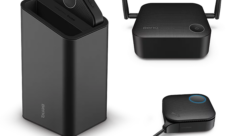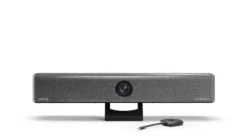Meeting the need
Jan 1, 2000 12:00 PM,
Jack McLean
Installing a complex, easily controlled and monitored A-V system for theMandalay Bay Events Center.
Technology advancements are providing systems designers and installers witha steadily increasing number of options to offer to their customers. At thesame time, keeping up with all of these changes can be more than a bitdaunting. Then, there is the big question: Just because something can bedone, does this mean that it should be done? The answer lies in a thoroughunderstanding of what the customer truly wants from a system, and then, howmuch he is willing to invest to realize his vision.
Michael Cusick, a veteran systems designer who heads up SpecializedAudio-Visual Inc. (SAVI), Clifton Park, NY, is used to answering the bigquestion. He regularly works with a global customer base, formulatingaudio, video and affiliated systems for a diverse range of venues andapplications. One of his latest projects features an application ofleading-edge technology at the new Mandalay Bay Events Center, a12,000-seat arena adjacent to the equally new resort and casino of the samename on the Las Vegas strip.
“From the outset, the customer made it very clear that the Events Center isan entertainment venue much more than a sports facility,” Cusick said. “Oneof the primary goals is to use the arena as a marketing tool to garner asmuch exposure for Mandalay Bay as possible. As a result, one of ourchallenges on the design side was formulating the best, most convenientbroadcast facilities to attract as many television broadcasters aspossible. Given a choice, and there are a lot of choices in Las Vegas, wewant them to choose the Events Center as the preferred place to do abroadcast.
“This philosophy also guided our design of the main audio system coveringthe arena. Again, taking the entertainment-first mindset, we needed todevelop a system for a much wider range of events and applications than istypical in the majority of sports facilities.”
The arena is configured in a rectangular shape with one main level ofseating surrounding the floor backed by luxury suites and press facilitieson both long sides of the rectangle. Portable risers on all sides allowseating to be extended further onto the floor, which accommodates aregulation-size ice hockey surface that is often used for skating shows.
The room offers a good acoustic signature, courtesy of Charles Boner ofBoner Associates, an Austin, TX, consulting firm, who worked closely withthe customer and architect on its acoustic design. The most notable facetis special acoustic panels that shroud the entire ceiling, dramaticallycutting reverberation. In addition, all seats have padded backs.
“Charles did a wonderful job with the acoustics,” Cusick said. “It’sobvious that he really knows his stuff. There was a big incentive to have agood acoustic signature, in general, because of the entertainment-orientedplans for the room, and, more specifically, because Luciano Pavarotti hadlong been signed to be the venue’s opening-night concert. He’s developed areputation of being very particular about acoustics and has been known tocancel a show if a venue’s acoustical environment is not suitable.”
The Events Center also houses a number of subsidiary rooms for meetings andsmall conventions as well as for press conferences at big events like prizefights. All of these spaces, along with the concourses, dressing rooms andrestrooms, were included in the systems designs created by Cusick, and arenow under the control of Karl “Lugus” Lugmeier, chief system operator.
Networking
The project marks one of the first networking applications of a PeaveyElectronics MediaMatrix digital signal processing, matrixing and routingsystem. In fact, two MediaMatrix mainframes are on an in-house network,along with a Crown IQ System for remote control and monitoring of the arenaaudio system’s power amps.
In the formative design stages, Cusick was already evaluating possibilitiesof being able to control the arena system from several locations in thefacility. During this process, he began discussions with Peavey, which wasjust finishing development of a Windows NT operating system platform forMediaMatrix. (Previously, it used a stand-alone Windows 3.1 platform.) WithWindows NT, MediaMatrix could be placed on a local area network (LAN) or awide area network (WAN) with access points throughout the venue.
“Windows NT with MediaMatrix opens up so many possibilities for controlfrom multiple locations,” Cusick said. “We decided that this was the bestway to achieve our goal, which was to attain control of the system from anyappropriately outfitted computer that could be plugged into the network atdozens of points.”
Two primary system control positions were established. The main position islocated in a secured room behind the arena’s main lower concourse, home toone of the MediaMatrix mainframes and most other audio, video and broadcastsystem components. The other primary control position resides in a room onthe press level, housing the other MediaMatrix mainframe. Both of theselocations are outfitted with two workstations, providing complete access toeither mainframe.
Access can also be attained at 32 A-V plugging boxes strategicallypositioned around the facility, each linked via Ethernet back to bothmainframes. As a result, system operators can check and modify the systemfrom virtually anywhere in the building by plugging in a laptop PC. Mostrecently, wireless Ethernet capability has been added with the laptop PCequipped with a PCM/CIA card capable of transmitting upwards of 300 feet(91 m) to a wireless Ethernet access point, plugged in via a CAT5connection at any of the A-V plugging boxes.
“Obviously, this is a great way to tune the main audio system, with theability to walk anywhere while making real-time adjustments to the system,”Cusick said. “In another recent application, we implemented this sameapproach with the additional capability of SIA SMAART software providinganalysis and generating pink noise that can be transmitted to the system sothat the analysis system and the control system are both wireless.
“A network hub installed in Karl’s office allows him even more convenientsystem access, and ultimately, we will be able to access the networkremotely just by dialing in. For example, we could access it from ouroffices in New York and be able to provide assistance with diagnostics ifthere’s a problem. The solution can be more immediate for the customer, andwe don’t have to get on an airplane and travel across the country.Situations like this represent what I believe will be the state of the artin customer service for the A-V systems industry.”
Unique routing
The MediaMatrix mainframe residing in the main control room on the lowerlevel is, in part, dedicated to a unique audio-for-video routing scheme. Itworks in tandem with a Leitch video switcher, which can route 16 differentvideo channels to more than 100 video monitors throughout the facility withmonitors grouped by the level of the building where they reside. The samevideo signal can be sent to all monitors, building-wide, or differentsignals can be assigned to groups of monitors. Video sources include DVD,VCR, tuner and such external sources as feeds from TV trucks. In addition,these feeds are also supplied to four Video Projections large-format videosystems, one in each corner of the arena.
The MediaMatrix mainframe receives the audio that accompanies all of thisvideo programming. Meanwhile, the Leitch switcher and Media-Matrix havebeen linked via RS-232 to share control information. An AMX AXCESScontroller serves as the translator between the two with the controlprotocol of the switcher modified within the AMX to Peavey PASHA (PeaveyAudio Serial Handling) commands. A cross-point switcher, in the form of a16infinity16 matrix, has been established in the MediaMatrix, so the resultis that audio can work alongside video or be routed independently using theLeitch switcher protocol.
“Video with matching audio can be sent together to the monitors and theircompanion ceiling loudspeakers in the same zone, or an entirely differentaudio channel can be sent with the video. For example, you might want tosee the TV feed of a prize fight but have music in the background asopposed to the broadcast audio,” Cusick said. “Or maybe management wouldlike a promotional DVD to be fed to the concourse monitors and loudspeakersonly with the rest of the building receiving some other A-V programming.What we’ve set up is a system for doing this that is easy to use with Karlonly having to do a couple of point and clicks in the Leitch software tomake it all happen.”
The same MediaMatrix mainframe performsother duties such as routing andprocessing of audio to all systems in the building with the exception ofthe main arena PA. In addition, the mainframe uses a straightforward roomcombining software from Peavey that allows easy, flexible management ofroom combining. This is especially useful for the audio systems in the 12meeting rooms in the Events Center, which can be combined or made discretewith a couple of clicks.
Virtual mixers have also been created within the mainframe, which enablethe blending and assignment of several audio sources, including local audiofor video and paging sources from throughout the building. These can besent to a total of eight different zones. For instance, if two of themeeting rooms are being used for a post-event press conference, video canbe routed to the monitors, and the audio for that video can be routed tothe respective audio systems in the rooms, while the live mics plugged intowall panels are active and fed to the audio system as well.
“All of this goes in the direction of letting the operator literally routeanything anywhere in the building from any location,” said Cusick. “It’s agreat way to manage a multi-layer, complex system with basic point andclick operation. There was a little learning curve with regard to thisapproach, but once you work with it for a few minutes and combine thatknowledge with acclimation to the entire facility and what exists in eachroom, you have complete control of every single element literally at yourfingertips.
“Many of the final settings were done with Karl’s help once he came onboard as the chief system operator. Being fresh to the project, he broughtsome great perspective and ideas to what we were trying to achieve, and wewere also able to tailor things more to his preferences. He was enormouslyhelpful. Being from a live sound background, it took a major leap of faithon his part to have to sit in front of a computer to control faders andother system components, but he came around to it quickly and has taught ussome things in the process. The bottom line is that we’re now at a pointwhere instead of putting a piece of hardware with 250 knobs in front of thecustomer, we’ve distilled it all down to simple screens that have only acouple of options to alter the system. The rest is hidden in layers thatdon’t even have to be exposed to the customer.”
Arena zones
The other MediaMatrix mainframe, as well as its affiliated Break-Out Box(BoB) hardware, reside in the arena system control position on the pressbox level. In its simplest description, this mainframe has also been set upas a 16-input virtual mixer that accepts local inputs (CD, DVD, digitalhard drives and paging mics) as well as line inputs from mixing consolesthat can be used at a number of locations in the arena.
The virtual mixer selects all sources and routes them out to the arena PAsystem, which is made up of 32 Eastern Acoustic Works (EAW) distributedloudspeakers mounted at catwalk level. Prior to distributing source output,however, the mainframe also applies digital signal processing as programmedby Cusick during the final system tuning and analysis portion of theproject. The operator is given some rudimentary processing functions, suchas EQ, to tailor the output a bit further; however, there are alsopassword-protected master settings that cannot be touched.
The 32 main loudspeakers are divided into 28 zones with each zone assignedits own virtual time delay units in the mainframe. Because one of theprimary applications of the arena system is to enhance coverage provided byPA brought in for specific productions, a significant amount of time andeffort went into establishing delay times for each zone depending on thelocation of the temporary PA. To achieve this, Cusick arranged for aforklift truck to be brought into the arena during final tuning. Theforklift was outfitted with a high-output loudspeaker which could behoisted into the approximate height and position of a temporary PA cluster.
“The loudspeaker was used to emulate a cluster that could be brought in fora live show, so we tuned the house system given all possible locations thatsuch a cluster could be flown,” Cusick said. “With the assistance of SIASMAART test and analysis software, we developed about a dozen differentpreset configurations with all 28 zones timed to the theoretical sourcepoint.”
A CAD drawing of the arena was converted to bitmap (bmp) format and thenloaded into MediaMatrix. The resulting planview was customized to show allpotential stage locations with Lugmeier able to select the appropriatesetup with a click of the mouse. The system automatically recalibrateditself for the given selection.
“This removes a huge amount of operator technique necessary to reset such alarge system, distilling it all down to some preset buttons,” Cusick said.”It’s very graphic and easy to use. The only way to make it easier would beto add a touchscreen, which just isn’t necessary at this time.”
The host computers on the Events Center network also include Crown IQ forWindows version 4.0 software, used to control and monitor the CrownMacro-Tech series power amps driving all audio systems in the arena. Theamps for the arena system are rack-mounted in a room behind the arenacontrol room while other amps for a range of applications are located inthe main control room.
An RS-232 serial connection links the network Ethernet hub with Crown INTinterface modules necessary for networking applications. CAT5 wiring wasused to deliver the IQ System loop to the P.I.P.-IQ plug-in modules on theback of each amp.
“It’s always nice to be able to keep an eye on the amplifiers, especiallyin a situation like this where they’re spread between two locations,”Cusick said. “At either of the system control locations, you can be workingwith MediaMatrix on one computer while IQ can be viewed on the other, andyou can access either of these with a remote computer plugged into thenetwork anywhere in the building.”
Broadcast nirvana
As mentioned, the Events Center features a cabling design that fostersconvenient interconnectivity with audio, video and broadcast systems.Cusick handled the A-V portion of this aspect with Steve Rice of Las Vegasand Tweeter Kulchar of Unitel, both experts in live TV remote production,lending their considerable expertise for the broadcast cabling side.
The 32 custom A-V plugging boxes, designed especially for this project byRice and Cusick, are distributed throughout the facility. Each box includesaudio trunks, video lines, coax lines, MATV distribution lines, Clear-Comintercom channels and the Ethernet connection to the network.
Many of the same A-V plugging boxes also include a wide array of broadcastcabling and lines. There are triax lines, digital coax lines, a 12-pairmulti-pin for broadcast audio, telephone lines and two types of fiber.Multi-mode fiber is used for in-house MIS purposes while single-mode fiberis allocated for broadcast and video purposes. All of these lines originateat racks of patch panels and control devices housed in the main controlroom.
“We’re talking about 125 triax connections in the building, 250 digitalcoax lines, 48 12-pair broadcast audio mults, 250 pairs of telephone linesplus tons of fiber,” Cusick said. The modular plates in the A-V pluggingboxes allows creation of complex configurations at each location. One ofthe boxes is located at a spot outside the building capable ofaccommodating up to 20 broadcast trucks; all of them can plug into this boxwithout having to make long cable runs into and through the building.Another box is strategically positioned next to the main door where one ortwo broadcast trucks are generally located. Again, easy, convenient accesshelps to attain one of the primary goals of making the Events Center aplace where broadcasters truly want to work.
Going distributed
The arena sound reinforcement system has been designed to supply relativelydynamic full-range performance suitable for a wide range of entertainmentand sports functions. As mentioned, it is also intended to be used toseamlessly support temporary PA systems when necessary. Both of these needspointed to a distributed loudspeaker approach as opposed to a centralcluster supported by satellite clusters.
Working with EAW, Cusick performed extensive modeling of the space to helpdetermine loudspeaker types and locations. The best approach proved to be32 loudspeakers arranged roughly in concentric circle patterns with eachloudspeaker as close to the audience as possible. They are arranged in fourmaster group zones – floor, front audience, remaining audience and endzone, all mounted in the grid at the catwalk level.
Four EAW AS490 mid/high loudspeakers in the center of the grid supply floorcoverage. Cusick selected these loudspeakers because of their tightcoverage pattern, and more specifically, he chose not to use full-rangemodels in this zone to prevent potential low-frequency build-up. A ring ofeight loudspeakers surrounds the center group, made up of EAW ASV7632full-range units, each with a 15 inch (381 mm) subwoofer, 10 inch (254 mm)horn-loaded midrange and 2 inch (51 mm) exit compression driver on a 60degrees infinity 45 degrees constant directivity horn. These eightloudspeakers cover the front audience area, including the temporarybleachers pulled out on to the floor for certain events.
A final outer ring of loudspeakers extends coverage from the front of theaudience area to the rear row on both long ends of the rectangle. Here,Cusick selected EAW ASV7652 full-range loudspeakers, offering greateroutput courtesy of dual 15 inch subwoofers, dual 10 inch loaded midrangeand single 2 inch exit compression drivers, again on a 60 degrees infinity45 degrees CD horn. Certain end zone sections receive bolstered coveragefrom more ASV7632s.
“One of the reasons we prefer EAW is that they offer the deepest line ofloudspeakers imaginable,” Cusick said. “EAW has a solution for virtuallyevery situation with all boxes performing in a uniform manner that makeseverything predictable while keeping coverage and sound quality asconsistent as possible. In addition, EAW provides excellent design support,which comes in handy on larger projects like this one.”
All loudspeakers are biamped with the three-way systems containing aninternal mid/high crossover. Crown MA-2400s drive the mid/high sectionswhile MA-3600VZ’s provide plenty of energy for the low-frequency sections.This approach was taken to cut costs without compromising performance whilealso eliminating some complexity from the system.
To allow for more flexibility in aiming the loudspeakers, Cusick devised acustom pan/tilt mounting system. At the time of the design, someconstruction issues were still being decided, and the goal was to be ableto work around any changes that might come up. The mounting devices includea pivoting knuckle assembly, which provides rotation. Once the loudspeakeris aimed, it can be locked into position. The pivoting assembly attaches tosteel beams in the catwalk with each of these secured between two adjoiningsupport beams.
“It was never the intent for this system to be able to handle a BruceSpringsteen concert,” he said. “What it does is work well for the clientfor what he needs with solid, tight full-range performance, and everythingis permanent and doesn’t have to be moved, so any configuration changes cansimply be achieved with the presets in MediaMatrix.”
Competitive advantages
The Mandalay Bay Events Center presented some distinct design challenges,but Cusick noted that all of the custom work paid off. In short, all facetsof the systems are performing as intended, fully realizing the customer’swishes and needs.
“Bits and pieces of many of the custom things we did here already exist inother venues, but this is likely one of the first times they’ve all beenbrought together in one facility,” Cusick said. “The customer knew from thebeginning that he could derive competitive advantages from all of thistechnology in the broadcasting system as well as on the audio and videosides of things. This is proving to be true.”
Recently, the Mandalay Bay contracted with American Hi Definition (AHD),Calabasas, CA, to complete its sports and entertainment arena. The12,000-seat venue needed to incorporate large-venue displays to communicatewith big crowds during, among scheduled events, the Luciano Pavarotticoncert in March 1999 and Oscar de la Hoya championship bout in May.Likewise, the multi-purpose arena is currently scheduling rock concerts,corporate events, television specials, trade shows, rodeos and hockeymatches that will use the large-screen displays when used for imagemagnification (IMAG) of performers and presenters along withcomputer-generated graphics to balance the program’s visual objectives.
So six months prior, Paul Opromollo, control room operator, and the rest ofthe casino’s technical staff asked around the industry to find projectionsystems versatile and bright enough to support the arena’s communicationsneeds during shows. Among other products, AHD brought in its fleet ofhigh-resolution Digital Projection POWER displays and found the projectorscreated film-like imagery capable of ultra-bright display of nearly anysource from the casino’s recently constructed control center.
“We chose projectors with reliability and maintenance in mind,” saidOpromollo. “The Digital Projection systems had clearly a better image andwere easy to set up, network and service.”
“The projectors are an added entertainment value in this setting,” saidBill Doak, director of marketing of the Mandalay Bay Resort. “If you buyeven the least expensive seats in the arena, the projection equipmentbrings you closer with images right in your face. Customers feel part ofthe show.”
To combat ambient light from ubiquitous advertising flat panel displays,scoreboards, spot and house lighting, AHD suggested installing custom-mademetal-framed, draped enclosures shaped like a cone to house the six POWER5gv, 5,000 ANSI lumen projectors (see photo, page 70). The four cone-shapedstructures, which retract from ceiling mounts via chain automated lifts,feature integrated stacking points to hold up to two POWER 5gv projectorsper mount for simple convergence and maintenance of multiple projectors.
“The venue’s video integration was designed with the future in mind,” saidPeter Nicholas, Digital Projection’s Pacific Southwest market developmentmanager. “Our projection systems feature the required digital stability,simple maintenance and application flexibility to grow as a casino’smarketing efforts expand.”
The final design also included audio and routing systems from the controlcenter that complement the large-screen displays to make every seat a frontrow.
“The six Digital Projection projectors receive their signal from thein-house A-V system, a sophisticated web of sound systems, video monitors,audio and video cabling and a series of A-V sources and routing systems,”said Mike Cusick of SAVI.
“Each projected image in any casino application – sports books, theatres,nightclubs, arenas – serves as a visual stimulus to the audience. Savvycasinos will integrate new methods to manage busy traffic areas inenvironments saturated with light and entertainment,” said Nicholas.










